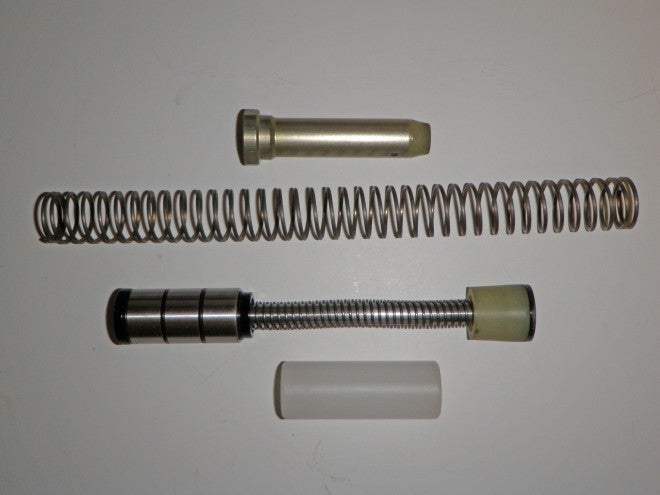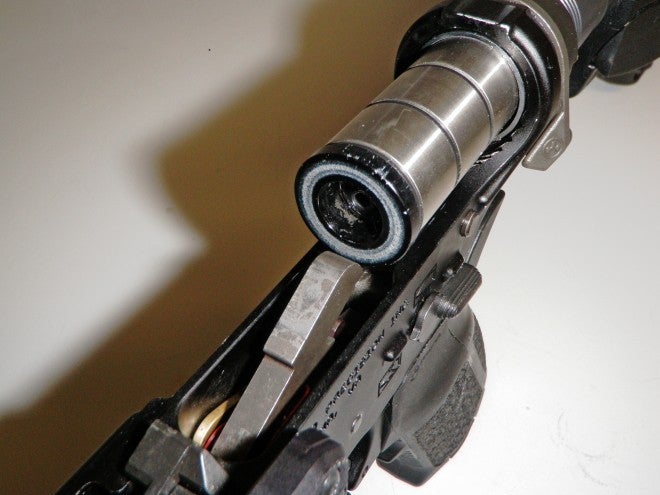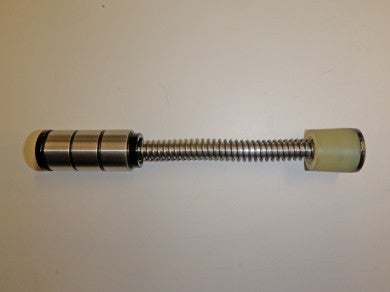When you start researching buffer springs for an AR15 you run across sever different springs, and buffers. The other thing that you run across is other AR15 owners telling you that you are trying to fix a problem that doesn’t exist. In reality, they are correct. The traditional buffer system works as designed. But there is one thing that many AR15 owners do complain about, the infamous “cheese grater” noise when shooting. Anyone who has shot an AR15/M16 knows exactly what I am talking about. It reverberates through your ear protection, and even the bones in your head. It is downright annoying to some of us, and livable to others. This is where a product made by JP Enterprises, INC comes into play.
The product is called a Silent Capture Spring. It is an odd looking spring that totally replaces your weighted buffer and buffer spring. The entire spring system is the size of a carbine tube. If you have a rifle length tube, there is spacer that is placed into the buffer tube behind the spring. The spring is actually fed onto a rod, and is held on both ends by retainers. It is like nothing you have ever seen for an AR platform.
So what does this strange looking spring that you put into your rifle do? Well, it does a few different things for your AR. First, it eliminates the “cheese grater” sound in your buffer tube. There is no more annoying noise reverberating through your jaw bone every time you pull the trigger. The second thing it does is reduce recoil, significantly. You standard 5.56/.223 round does not have all that much recoil anyway, but there is just enough to be annoying when trying to shoot at a more rapid pace and stay on target in say a competition, or tactical exercise. What it does it make the recoil happen in a much smoother manner, and because the spring does not allow the buffer to bottom out at the back of the stroke, it eliminates that jarring that you can get from that shock. Also, by eliminating the buffer it removes that weight from cycling back and forth with the bolt carrier group, which in turn reduces the mass being cycled.

Silent capture spring system, with rifle buffer extension.
The third and final thing that the new spring will do with make you wonder how you ever shot an AR15 without one. It makes everything cycle at an incredibly smooth rate. When I installed this spring in an Adam’s Arms piston AR15, and pulled the trigger for the first time, if there wouldn’t have been a muzzle report, I would have guessed there was a misfire. It was absolutely amazing just how smooth and quiet the rifle had become. After many years shooting all types of firearms, in many different settings I have never been so blown away by single product. After learning just how the new spring had changed the way my rifle shot, and adjusting to that change I noticed that my groups were tighter and my follow up shots were much faster and more accurate.
One place that you cannot use this spring system is in a solid BCG system, like a pistol caliber carbine. The reason is that there is a guide rod that the BCG will actually over lap. Having a solid BCG, or one with a closed back does not allot the guide rod anywhere to go, and the rifle will not cycle. Also of note, JP engineers claim that the spring works right out of the package for right around 95% of all rifles out there. But just in case there is a problem, or you want a more finely tuned spring, there is a spring pack sold that has varying weight springs. You will want to read the instructions carefully on how to change the springs out, failure to follow them can lead to destroying your spring system.
One positive to the system is that you can also remove the buffer retainer and retainer spring from your rifle. This spring system will not expand past the end of the buffer tube, and removing the retainer makes removing the spring system easier to remove for maintenance. In my rifle I actually left mine in, and sanded it down to a small nub so that it still retains the spring, but doesn’t hinder taking it out. Because of the rigidity of this system, it is much harder to get out when there is a buffer retainer in the way. The other thing you might find in the way when removing the spring is the hammer, you can solve this problem by releasing it, the spring will not hit the hammer when it is in the fired position.
All in all, this system doesn’t fix a single mechanical problem. Many will say, that like so many other AR part out there, it is a solution in search of a problem. But there is a difference between fixing a problem and upgrading. This spring system is an upgrade, pure and simple. It will blow your mind how smooth is makes your rifle. My brother Chris bought one for his rifle as well, he describes shooting it as “[A] little rough at first. Like most things gun related it definitely needs to be broken in. In my experience it likes to be run really wet. Once you’ve gotten used to it, it really cuts down on the noise in the buffer tube. Very smooth operation and the reduction in recoil helps keep the muzzle down for quicker and more accurate follow up shots”
The only drawback to this system can be the price. Many I have talked to find it hard to swallow spending almost $140 on a buffer spring for an AR. Many times I hand people my rifle and tell them to shoot it, and after that they are not only converts, they are rushing home to get a new spring for their rifle.
Pros:
- Smooth shooting
- Reduces recoil
- Simple install
Cons:
- Expense
 Your Privacy Choices
Your Privacy Choices



